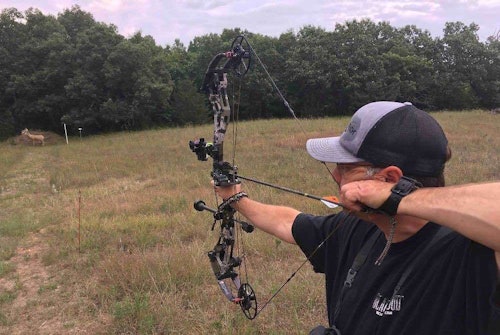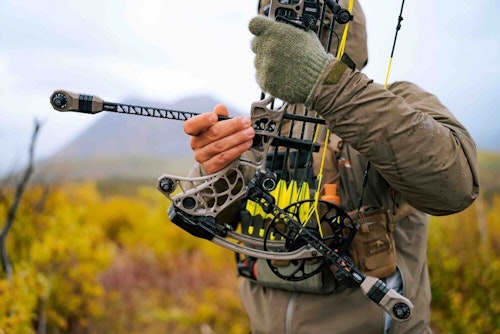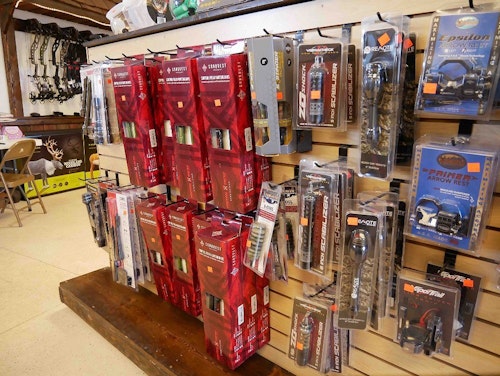When customers walk into a pro shop to purchase a new bow setup, there is a lot of talk about which compound is the smoothest, quietest or fastest. Once they settle on the right bow for them, the next obvious and nearly exciting choices are the arrow rest and bowsight that best fits both their shooting style as well as their pocketbook. Yes, all of these are, of course, important decisions, but often overlooked are which stabilizer and quiver best fits a particular archer/bowhunter. Simply just grabbing “whatever” off the shelf and strapping it on a bow can work, but picking the right quiver or stabilizer can lead to a better and more accurate shooting experience.
Deciding which products to stock your shelves is always a challenge. Of course, as storeowners, you must sell products where money can be made, so we should always strive to find the best products with good margins. This can take some research, but it’s worth the time for your bottom line.
Another consideration is how many different options to have on hand. Big box stores have the luxury of plenty of wall space and usually investors with deep pockets; they can afford to carry seemingly every product made. If you own or manage a small- or medium-sized shop, I’m sure you know all too well that this isn’t generally your reality. So, having a good sampling of varying products that you know work well will usually suffice. It is always a good idea to let customers know that you can order other products, but be willing and ready to explain to them why the products you carry are worthy of their consideration.
Being able to educate consumers on a certain quiver or stabilizer is pivotal. It goes beyond just saying, “This is what I sell, and it’s X amount of dollars.” You should explain to them exactly what it is, how it works, and what they can expect from that product after they purchase it.
Keep It Steady
Stabilizers are an interesting piece of equipment because they generally don’t have any moving parts and they are kind of “just there.” For something not very glamorous or flashy, they are an important part of ultimate accuracy. Educating your customers about using the right stabilizer for a better-balanced bow can surely lead to more sales and happier customers.
Still, you have to overcome some preconceived notions when it comes to stabilizers. I hear it all the time from friends, on the Internet, or when I am in the pro shop: “I don’t need a stabilizer.”
These comments are true to an extent with bows being quieter and deader in hand than ever. That being said, as a shop owner, you no doubt have a high-quality stabilizer bolted on your bow, and know full well the benefits of using it. So, articulating why you have one and why your customer should consider one, should be your goal. Make it known to them that beyond making it easier to hold the bow on target, a stabilizer will also lead to much less vibration and noise on the shot.
Having several different stabilizer options for customers is the best way to show them what they might be missing. In my opinion, having them shoot each bow without a stabilizer is the best option. Once they have shot the bow and know what it is like to shoot bare bones, it’s time to put on a stabilizer. Regardless of which stabilizer you put on the bow, they will likely feel and hear the difference. From there it is worth the time and effort to have them try some different models of different lengths and weights. As you know, many models are capable of adding and removing weights to the end, and it is worth bringing this to a buyer’s attention when showing them different options.
I spent some time talking to Bud Robinson, owner of Downwind Archery, a successful archery shop in Idaho Falls, Idaho, that has been going strong for more than 25 years. I asked him how much the stabilizer market has changed in his business’s existence. “It’s not as crucial to have a stabilizer up front as it once was because of how quiet and vibration-free today’s bows are,” he said, “but I think they are still helpful. I find that my customers are much more interested in front and back bars that are aimed at balancing the bow more than vibration dampening.”
Robinson brought up a few points that are worth mentioning as well. Having some good side and back bars as well as standard stabilizers is a smart plan. Having a well-balanced bow that customers can hold and try is a great idea, whether that’s just a shop rig or your personal bow. If they can see and physically feel how much better a well-balanced bow aims, it could lead to more sales and happier customers.
All It Does Is Hold Arrows?
Yes, the primary goal of a quiver is to hold your arrows. But for just being an arrow holder, there sure is a wide variety of options, and companies are always tweaking and building new models. Is some of that the result of always trying to market a new product to make more money? Of course, that is some of it, but quivers have also come a long way in recent years, and they just keep getting better. Manufacturers have built quivers to fit tighter to the bow and balance better, and have made them lighter and quieter, and that’s a good thing.
When talking to Robinson about quiver options, he said, “I’ve quit carrying two-piece quivers because of all the different mounts for specific bows. I let people know I can order whatever, but I have only one-piece quivers on the wall that I know will fit any bow.”
From a business standpoint, this makes a lot of sense. That being said, there are some top-notch two-piece quivers on the market that are worth consideration. When making inventory decisions, make sure if you order two-piece quivers that they fit the bows you have on your wall, or are universal to fit most models. It’s also important to consider your store’s location and your typical customer. For example, most whitetail hunters in the Midwest, East and Southeast hunt from treestands or ground blinds, and they prefer to remove a quiver immediately upon getting in the stand. Almost all of these hunters will want a one-piece quiver that’s fast and quiet to remove from their bow. Western bowhunters who spot-and-stalk muleys, elk and pronghorns are more likely to purchase a well-made two-piece quiver because it will stay attached to their bow.

When it comes to how many models to carry, Robinson has a strict policy that I believe is good business. If he wouldn’t feel comfortable on a hunt with the product, then he won’t sell it. So he stocks his shelves with quivers at three different price points.
Budget models are good for the person new to archery, or someone who just doesn’t have a ton to spend. As I mentioned, though, this product still needs to be more than good enough to handle the rigors of plenty of use. A great option is the Trophy Ridge 5 Spot Arrow Quiver; it’s priced right at $50 and will do everything a customer needs, and will leave a little money to spend on arrows or other accessories.
Second is a middle-of-the-road product in that $70-$100 range. For example, the Redline RL-2 Carbon Hybrid 5 Arrow Quiver is a great mid-range option that is well-built and suitable for most archers. Many models such as this one and other great quivers in this price range have come out in the past few years. I’m not sure if patent periods are running out, but there seem to be some great quiver models out there that function and look similar to most top-end models from just a few years ago.
One thought comes to mind when I think about mid-priced quivers: Competition among quiver manufacturers is good, and your customers benefit from companies jockeying to provide outstanding products at good prices. Word of mouth will drive sales in your store, so don’t be surprised that when a few shooters have success using middle-of-the-road Brand X quiver, that others will want the same model, too. It’s a smart idea to have some of your staff or local archery gurus shoot a few of these middle-of-the-road quivers on their bows. People tend to trust and look up to these individuals, and if they are using Brand X quiver, others will think, “If it’s good enough for them, then it’s good enough for me.”

Last but not least, you have top-end quivers such as the TightSpot Shift Lock 5 Arrow Quiver. Yes, at $200 it’s expensive, but bowhunters who want the best of the best for their setups will gravitate to top-end accessories. Although you don’t have to push people to the highest-end options, having name brands such as this will literally sell themselves to many guys who are in the know and know what they’re after. Many of your top shooters in the area will likely already be shooting products such as this, not because they are always significantly better, but rather because they are conditioned to shoot the highest-end products. I spoke about “word of mouth” driving sales for mid-priced quivers, and the same is true here. If bowhunters looking to buy a new quiver see almost all the top shooters in your shop with top-end Brand Y mounted on their compound, then don’t be surprised to sell even more of Brand Y down the road.
Final Thoughts
Stabilizers and quivers are not the most glamorous archery products to discuss with customers, but quivers are almost always necessary, especially for bowhunting, and stabilizers can greatly enhance a shooter’s experience and accuracy. As mentioned previously, it’s about having products on your wall that are functional and a good value, while keeping price points in mind. Think “good, better and best” as you decide what to stock and you’ll be on the right track.
Another topic I touched on briefly was your shop regulars being willing to help out. I’ve never been to a good pro shop that doesn’t have its “regulars” hanging around shooting bows — or just shooting the bull. It’s worth your time to see if these guys (and girls) are willing and able to help educate other customers on worthwhile bow accessories, or any products for that matter. These folks are in your shop, other customers like them and trust their opinions, so why not utilize them?
The little bit of extra time spent on every single sale is always worth it. Customers who leave your store feeling valued and with a love of archery will mean return customers and good word-of-mouth marketing, which will bring in new customers.
Sidebar: Selling the Right Stabilizer
In order to sell the right stabilizer to a customer, you must first ask them to explain how they plan to use it. For example, if the person is a whitetail bowhunter who plans to limit their shots to 25 yards from a treestand or ground blind, then a short, lightweight stabilizer will be ideal. However, if the bowhunter is hunting out West, or is shooting a lot of 3-D courses where yardages can be 40, 50 or 60 yards (or more), then a longer stabilizer is more practical. Also, adding a back bar might be worthy of a hard look.
Sidebar: Mathews Bridge-Lock Stabilizers and LoPro Quivers
It’s worth noting in a feature article about stabilizers that a primary selling point for the 2023 Mathews Phase4 flagship is how it incorporates the company’s new Bridge-Lock Stabilizer, which of course, is sold separately. Mathews is known for its innovative designs and superb manufacturing, and Bridge-Lock Stabilizers are an extension of its top-notch offerings. At the time of this writing, it appears consumers who are buying a Phase4 are showing their approval of the Bridge-Lock Stabilizer system with their spending.
Archery Business Editor Dave Maas recently visited Schaffer Performance Archery in Burnsville, Minnesota (photo above), and talked to owner John Schaffer about the topic. When asked whether the high price tag for the Bridge-Lock Stabilizer was limiting sales, Schaffer grinned, gently shook his head side to side and said, “No sir. Let me put it to you this way: It’s rare for us to sell a Phase4 and not fit it with a Bridge-Lock. Is it spendy? Oh, yeah. Are customers still buying it? Oh yeah. And the reason is because they can feel the performance difference on the range.”
Depending on length (8, 10 and 12 inches), the Mathews Bridge-Lock stabilizer is priced at $249.99 to $269.99. The 10-inch model ($259.99) weighs 6.96 ounces, and includes two 1-ounce Bridge-Lock weights. Additional 1-ounce weights can be purchased for $19.95 each and quickly added to the stabilizer.
Schaffer also shared that customers leaving his store with the latest Mathews flagship almost always purchased the company’s LoPro Detachable five arrow quiver ($249.99), too. The quiver is built exclusively for the 2022 V3X, and 2023 Image and Phase4.
In other words, customers who are ready to drop $1,299 on a Mathews Phase4 29 or $1,399 on the Phase4 33 are ready and willing to spend at least $500 more on a stabilizer and quiver built specifically to match their new bow.










